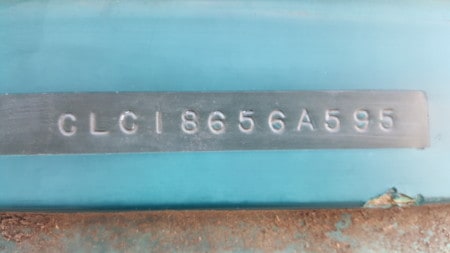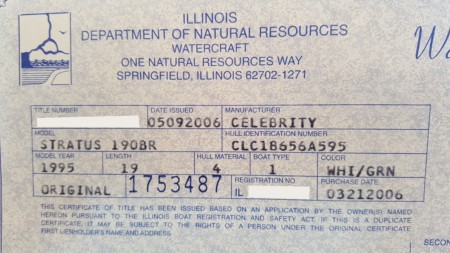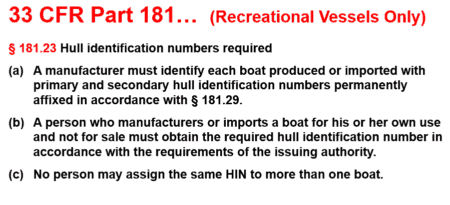Having had many boats over the decades, I’ve had to verify a lot of boat’s identification numbers. I’ll show you where these numbers are located on the boat and how to break down the characters to understand what it means.
Boats use a set of identification characters called a HIN (Hull Identification Number). Most other vehicles such as cars, motorcycles, trailers, etc. use an identification system called VIN (Vehicle Identification Number). You will find the HIN located on the Starboard Aft of the boat. Meaning the Right side of the transom (Rear) of the boat.
The HIN tells you who manufactured the boat and when it was built, along with the specific serial number of the boat. So now let’s look at what the HIN is telling us about your boat. You just might be surprised!
The HIN Decoded
 A VIN and a HIN provide much of the same information about their respective vehicle. So when looking at the HIN in the image, you’ll notice that the first 3 characters are letters. These letters are the manufacture code that depicts the boat’s manufacture.
A VIN and a HIN provide much of the same information about their respective vehicle. So when looking at the HIN in the image, you’ll notice that the first 3 characters are letters. These letters are the manufacture code that depicts the boat’s manufacture.
The next 5 characters represent the serial number for this specific boat.
The the last 4 characters tell us the date of manufacture and the the boat’s model year. So now let me show you how this all breaks down.
- The first three characters are “CLC”. This depicts the manufacture of the boat is “Classic Crafts”.
- The next five characters are “18656”. This is the serial number of the boat.
- And the next characters is “A”. The letter “A” is the first letter in the alphabet, meaning the boat was built in the first month of the year “January”.
- Next is the number “5”. This states that the build year is “1995”.
- The last two characters are “95”. This depicts the model year of the boat is a “1995”.
Finding Boat Manufacture Codes
There are over 16,000 manufacture codes. So how will you know what each code means? Well, you could research each one. You could have a list of all of them. Or you could punch the three characters into Google. For the above boat your Google search would look like this “Boat Manufacture Code CLC”.
 While one might think that this boat was manufactured by “Celebrity Boats”, we find out that this manufacture code is actually registered as “Classic Crafts”. When you look at the title for this boat to the right, you see the manufacture listed as “Celebrity”.
While one might think that this boat was manufactured by “Celebrity Boats”, we find out that this manufacture code is actually registered as “Classic Crafts”. When you look at the title for this boat to the right, you see the manufacture listed as “Celebrity”.
Fred Claxton (who started Celebrity boats in 1979) left in 1991. The last Celebrity made was in 2001. Celebrity Boats were made by the companies that took them over after 1991. This is likely why the Manufacture code doesn’t match the manufacture name on the boat or the title.
This isn’t an uncommon scenario. It’s much like small companies being taken over by larger companies. Look at how many different names of companies are actually owned by Westinghouse. Google it, as it’s pretty crazy.
Anyway, the manufacture code will depict who built this exact boat. There are HIN decoders in the search results such as HIN Decoder.com. But if you would like access to every manufacture available, along with their full address, then go to USCG Boating here.
Boats built after November 1, 1972, were required to be manufactured with a HIN on the boat. Most of these are stamped directly into the transom (back) of the boat. However, I’ve seen some that are a riveted plate.
Can The HIN Be Found In More Than One Location?
 It’s common for there to be a secondary location for the HIN. This is often not disclosed or easily found. The reason for this is that if a boat is stolen and/or the HIN was altered, law enforcement has the ability to check the secondary HIN location to verify the true identity of the boat.
It’s common for there to be a secondary location for the HIN. This is often not disclosed or easily found. The reason for this is that if a boat is stolen and/or the HIN was altered, law enforcement has the ability to check the secondary HIN location to verify the true identity of the boat.
I’ve never run across a primary HIN that wasn’t clear and unaltered. If for some reason you want to find the secondary location, you may be faced with difficulty. I’ve read about people that have called the manufacturer and been refused the secondary location. They had required forms to be filled out by law enforcement to release that information.
However there are many cases where people have found them on their own. But, just because an owner found it on his boat, doesn’t mean that the manufacture put it in the same location on yours.
What If The HIN Looks Altered?
While this is a personal decision based on your risk tolerance, there are a couple things you can do to reduce your risk. If you’re considering purchasing a boat that seems would be a good fit for you, but the HIN looks altered:
- Compare the title to the HIN. Are they the same?
- How long has the boat been titled? The longer the better. If they got title to the boat a while back and no issues were raised, you’re probably OK.
- You could look for the hidden HIN to see if they match. This wouldn’t be easy, but you could try calling the manufacture and see if they would give you the location. You could also describe the imperfection in the HIN and ask if this is normal for them.
- You could ask the seller if they would mind letting a police officer look at it. The police most likely aren’t going to know anything, but you’re asking more to see the reaction of the seller. If they’re guilty of something, they will not want an officer there. However, there could still be an issue with the HIN and the seller know nothing about it.
- If the boat has been titled with a current registration for a while and the Department Of Natural Resources has not “red flagged” it, most likely it’s legit.
If you don’t find the second HIN location, then none of the above suggestions are a guarantee. One thing to remember when buying a boat is, that there’s always another nice boat for you to buy somewhere else.
Buying a boat is supposed to be exciting and fun. You’re supposed to have a boat for enjoyment and stress relief. Why would you want to buy a boat and then stress about it?
What If The HIN On The Title Doesn’t Match The Boat?
 In my opinion, I would take my bag of money and walk away. Again there are plenty of other boats for sale.
In my opinion, I would take my bag of money and walk away. Again there are plenty of other boats for sale.
While it could have been a simple mistake, the fact is that the person on the title doesn’t really have the right to sell that boat. They have registered ownership of a different boat Hull Identification Number.
Is it just a “typo”? Perhaps, but the title holder needs to have it corrected before he can claim ownership and have the right to sell it. Would you close on a house where the documents reflect a different address or legal description? Of course not!
Can I Paint Over The HIN?
The short answer is “no”.
Again, this is a decision you need to take based on you risk level. The law states that you can not paint over your HIN. However, this happens quite often with no repercussion.
On the image of a HIN above, you will see that in this case it would be easy to recolor the boat and mask off the HIN. No laws broken. But that’s not always going to be the case, depending on how the HIN is applied.
Your main goal when doing a topside paint, is to be sure that the paint is not filling up the indented hull identification number. Don’t only be worried about a DNR or a Coast Guard check, but also be thinking about when you’ll want to sell the boat. You don’t want your potential buyer to be suspicious or wonder if the HIN has been altered.
No matter what, you want to be sure the end result of the paint job allows for a perfectly legible HIN.
Can You Wrap Over A Boat HIN?
I am “wrapping” up this article, but also if you’re considering wrapping your boat, don’t have your HIN printed on the wrap material. You need to have the original HIN showing at all times.
Think of your HIN just like a VIN. They both need to show as original and unaltered. By law you can not apply wrap material over your boat’s HIN.
Remember, the HIN is to identify your boat and it’s needed to title your boat. Your next step is to verify whether your sate requires you to title your boat. Check out the boat title law in each state here.

